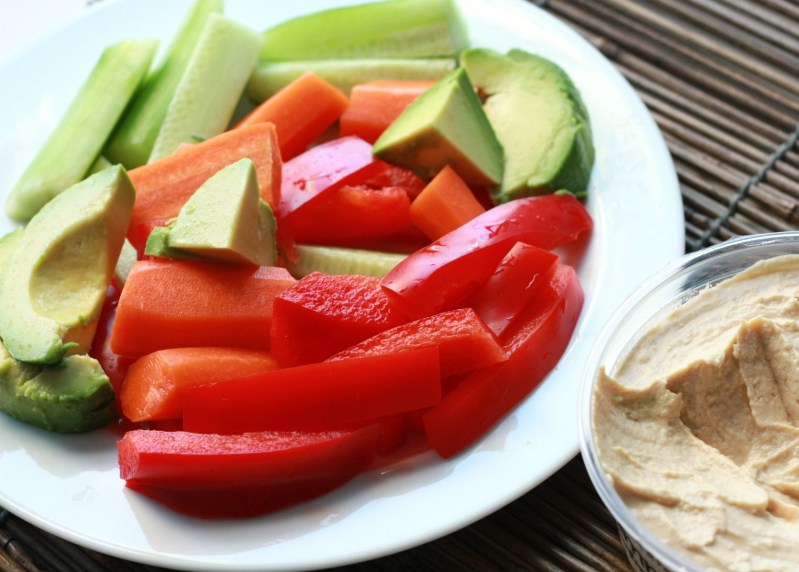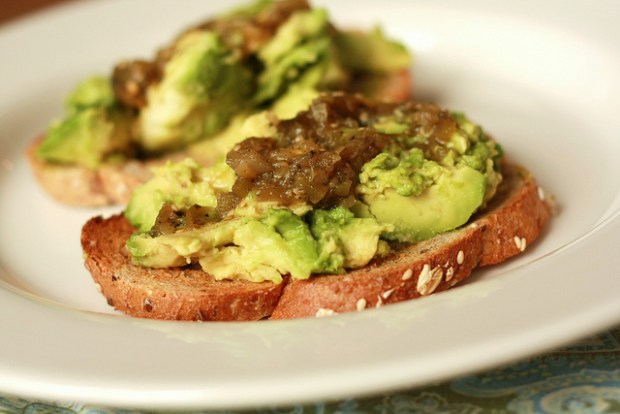
Get Fit is our new column on how to maintain a healthy lifestyle without losing your mind. After all, being fit doesn’t just mean subsisting on air-popped popcorn or dead-lifting 200 pounds. We’re here to answer all the questions you were afraid to ask: from how to eat well while traveling and how to choose healthy snacks that actually satisfy your cravings to a friendly guide to the wide world of the weight room. There’s no need to completely change your life overnight, either; we’re all about making small changes, one at a time. Get Fit goes out and asks the experts to demystify the wide world of health and fitness, everything from vegetables to cardio.
When you spend eight hours a day sitting at a desk, it can be difficult to snack well. What with donuts in the break room and Sally from Accounting baking cookies for the entire office, it’s difficult to appreciate those carrot sticks you brought. It almost feels like you’re doomed to forgo your health in exchange for all the decadent snacks that seem to be staples in offices across the country—but that’s not really the case. Nor are you doomed to ignore those maple-glazed beauties for the rest of your life. You’re a reasonable dude, and you deserve reasonable advice.
We talked to Tali Sedgwick, a registered dietitian and the brains behind Food NE/RD, a San Francisco-based nutrition counseling center that focuses on individualized health plans, about how to snack healthily without sacrificing flavor.
“I want to stress that you can make healthy food taste good,” Sedgwick says. “Healthy eating is not a punishment by any means. You just need to figure out what your flavor profile is.”

On Snacking
Sedgwick emphasizes the importance of snacking. “Snacking itself is really good for you. It keeps you focused.”
Eating between meals can fill in some of the nutritional gaps that come up during regular mealtimes. Sedgwick says that “very few people get all of the whole-grain, vegetables, and fruits that they should from their meals.” Snacking mindfully can fill in some of those gaps. It also helps keep blood sugar levels stable, which will allow you to focus more at work. Low blood sugar can lead to headaches, fatigue, and trouble thinking clearly.
Sedgwick says you want to make sure you’re eating frequently—every 3 to 4 hours—so your blood sugar levels don’t swing wildly. That being said, snack when you are truly hungry, or else it could lead to mindless munching.
Also keep in mind what Sedgwick calls the Danger Zone: the hours between lunch and dinner. Most people take lunch around noon and don’t eat dinner until close to 7. She says that often blood sugar can dip dangerously low between these meals, so eat a snack before heading home. Snacking ensures that you won’t overeat when mealtimes come around.
What To Look For
You should snack smart.
Sedgwick says that you should consider what kind of food you like to munch on—salty, sweet, creamy, crunchy or soft—and then plan from there. Like sweet stuff? Go for fruit! Like salty? Find yourself some crackers.
And hey, if you want a cookie, eat a cookie. The most important aspect of eating well is making sure you don’t feel like it’s a punishment, according to Sedgwick. Healthy eating isn’t about making certain foods off-limits. Sedgwick tells her clients that if they vow to never have a cookie again, they’re going to eat a whole bag of cookies when they’re having a bad day. Just remember to indulge reasonably, and rely mainly on healthy snacks that’ll actually keep you full and give you energy.
Food, according to Sedgwick, can be loosely categorized into three main nutrient groups: carbohydrates, protein, and fat. These three macronutrients are our main sources of energy.
Aim for snacks that hit two of the three macronutrient groups, because the combination of multiple food groups will keep you fuller longer.
Related: Feasting: Healthy Recipes From Our Favorite Chefs
A Note On Pre-made Snacks
Don’t have time to make carrot sticks or your own hummus? No problem! Sedgwick says buying pre-cut veggies and prepackaged food like crackers or hummus is a fine way to go. Just make sure you pay attention to the side of the box, not the front when it comes to prepackaged food.
“The word ‘natural’ doesn’t really mean anything,” she says. “Instead you want to look at the nutritional information and the ingredients on the side of the box.”
Nutritional labels can be, well, intimidating, but Sedgwick says there are a couple of tricks to parsing what those labels actually mean. The first ingredient listed is the main ingredient in the food. So if you see sugar listed first, avoid that snack. It means the large majority of that snack is made of sugar. Sedgwick also says to adhere to Michael Pollan’s rule and look for food with five or fewer ingredients.
“The simpler, the better,” she says.

Snack Attack
Sedgwick gave The Manual several ideas for easy-to-make snacks that will fill you up and keep you energized.
For The Sweet Tooth
If you crave a little sweetness, focus on satisfying your sweet tooth with fruits, which are chock-full of naturally-occurring sugars. But stick to the two macros or more rule that Sedgwick outlined and pair the carb-laden fruit with something that has fat and/or protein, like cheese, nuts or nut butter.
Sedgwick says a good way to go is to munch on apple slices with either a handful of raw almonds or a tablespoon of nut butter. Just make sure when buying nut butter to look for a brand that has no added oil. Nuts are already naturally high in (good) fat, so added oil is totally unnecessary! The combination of the carb-laden fruit and the fatty, protein-rich nuts will fill you up and keep you going.
For The Savory Craver
For Those Who Want Crunch
Need a little more in the way of crunch when it comes to snacking? No worries. Instead of reaching for the potato chips so you can drown out the sound of Sally from Accounting with your chewing, go for cut-up veggies and either hummus, black bean dip, or string cheese. If you don’t have time to chop your own carrots or celery, Sedgwick says the pre-cut stuff at the grocery store works the same. You’ll get the crunch and carbs you’re craving, and the hummus or cheese will give you the fat and protein you need to really make the snack stick.
For The Carnivore
Okay, okay, we get it. All of the snacks so far have been vegetarian. And while they’re all delicious, sometimes you just need a little bit of meat to get you through the day. That’s why Sedgwick suggests making your own turkey and cheese roll-ups. Pick a nitrate-free turkey and a low-fat cheese so you get all the nutrition and flavor without as many calories. These roll-ups are light, simple, and easy to make ahead of time. You can bring a week’s worth to put in the work fridge and just pick at them as needed.
Looking for another option if turkey isn’t really your thing? Tuna (the kind packed in water) with crushed black pepper and either cheese or veggie sticks is a great alternative. Same mix of protein and carbs, different flavor profile.
Of course, these aren’t the only flavorful snacks out there that’ll keep you full and also satisfy your nutritional needs. As long as you stick to Sedgwick’s suggestion of at least two macros per snack, you’ll be good to go.
Images courtesy of Sweet On Veg via Creative Commons.



